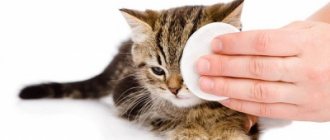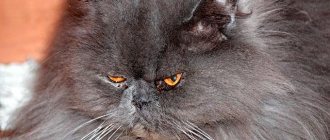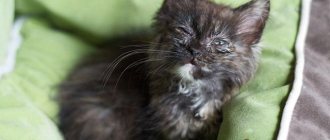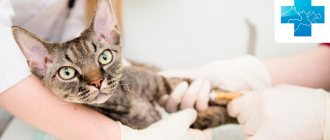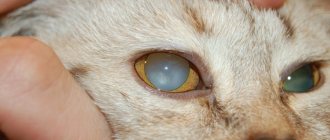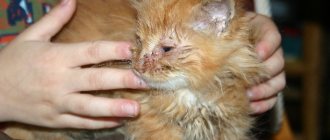Eye disease in cats Diseases of the nervous system accompanied by prolapse of the third eyelid Signs of other diseases 3veko
Sometimes cat owners discover that their pet has one or both eyes partially covered with a grayish film. This is a reason to more carefully evaluate the cat’s well-being and behavior. The third eyelid in a cat is an important part of the auxiliary apparatus of the eye.
In cats, the third eyelid, or nictitating membrane, is a fold of the conjunctiva at the inner corner of the eye. In a healthy cat, the third eyelid is usually practically invisible, and when the eyes are closed, the nictitating membrane covers the entire surface of the cornea, helping to moisturize it.
A visible third eyelid in a cat always indicates certain problems that require diagnosis of the causes of its loss and treatment.
Why doesn't a cat open one eye?
A constantly squinted or completely closed visual organ is a consequence of a pathological process in the body. All ophthalmological diseases in pets are divided into 3 groups:
- eye diseases;
- pathologies that arose against the background of other disorders;
- traumatic diseases.
If a cat’s eyes cannot open, the most common causes are the following pathologies:
- Keratitis, or inflammation of the cornea. Damage occurs due to injury, entry of a foreign body or chemical substance, or infection. Sometimes keratitis occurs against the background of helminthic infestation. It is accompanied by photophobia, lacrimation, discharge of pus, and redness of the corners of the eyes. Due to severe pain, the animal behaves restlessly and refuses to eat and drink.
- Conjunctivitis, or inflammation of the mucous membrane. The disease develops due to bacteria, viruses, and fungi entering the body. Inflammation of the conjunctiva may be one of the manifestations of allergies (to pollen or dust). Symptoms of the pathology include increased lacrimation, redness and swelling of the eyes, and discharge of pus.
- Glaucoma. Intracranial pressure increases due to injury or systemic disease. The outflow of intraocular fluid is disrupted. This leads to an enlargement of the eyeball, decreased visual acuity, and clouding of the pupil. At first, the cat or cat squints because it feels discomfort. In later stages, blindness is possible.
- Blepharitis, or inflammation of the edge of the eyelid. The disease occurs against the background of injury, infection, vitamin deficiency, parasite infection, burn (thermal or chemical). With blepharitis, the eyelids become red and thickened. The purulent scales that appear at the base of the eyelashes fall off and leave behind ulcers. The animal is in pain and constantly squints.
- Corneal erosion. The causes of its appearance are injuries, burns, viral, bacterial and fungal infections. The pet squints and scratches its eye with its paw, and behaves restlessly. Orientation in space is disrupted. If erosion is left untreated for a long time, a corneal ulcer may appear.
- Epiphora, or excessive tear production. Outwardly, the disease looks as if the animal is crying all the time. This leads to partial or complete blockage of the nasolacrimal duct. Epiphora can be congenital or acquired. An advanced form of pathology leads to the appearance of dermatitis.
A cat or cat may squint the visual organ due to mechanical injuries to the cornea. Most often this happens to pets that have free access to the street. Eye injuries received during fights or games with other animals often lead to inflammatory processes.
At what age do kittens open their eyes?
Veterinary specialists and breeders generally believe that kittens normally begin to open their eyes 5-15 days after birth. Before this, their eyelids are tightly closed, and babies learn to perceive the world around them with the help of other senses.
Eye opening occurs gradually. First, narrow slits appear through which a limited amount of light enters. At this moment, the kittens are not yet able to analyze the meaning of the information received in this way, so their pupils remain motionless.
Gradually, the eyes open completely, and the organs of vision begin to fully perform their functions.
If kittens do not open their eyes 2 weeks after birth, then they need human help. In most cases, a single rinse with a strong infusion of tea helps. However, if this is not enough, the eyes become covered with purulent crusts, become inflamed, or continue to remain closed, then you should contact a veterinarian.
Owners should pay special attention to a kitten if only one eye does not open, as this may indicate the presence of a serious pathology.
Diagnosis of the disease
If your pet constantly closes its eye, a veterinarian will find out the reasons. If alarming symptoms are detected, it is necessary to take the cat to the clinic.
Diagnostics includes procedures such as:
- visual acuity test;
- assessment of the general condition of the body;
- examination of the visual organs for damage;
- comparison of symmetrical features (size and shape of pupils, eyelids, eyeballs and slits);
- Ultrasound of the affected area;
- staining test;
- CT or MRI of the brain;
- X-ray of the skull.
Ophthalmological pathology may be a consequence of traumatic brain injury. Therefore, the examination must be comprehensive.
It is recommended to donate blood, urine and feces for analysis. Problems with the eyes can be caused by pathologies of internal organs or parasitic diseases.
Diseases of the nervous system accompanied by prolapse of the third eyelid
If prolapse of the third eyelid is accompanied by a narrowing of the pupil of the same eye, drooping of the upper eyelid, and an apparent decrease in the size of the eyeball, this is a reason to show the cat to a neurologist as soon as possible, since the complex of these symptoms (Horner syndrome) often indicates damage to the nervous system. The reasons for such a lesion may be different; in some cases, in addition to a neurological examination and routine tests, additional diagnostics are necessary - CT, MRI, and some others.
Methods for treating eye diseases in cats
If your cat squints or squints, it needs to be seen by a veterinarian. The specialist will find out the cause of this phenomenon and prescribe treatment.
However, not everyone has the opportunity to immediately take their pet to the clinic. In this case, it is recommended to examine the animal at home and provide first aid.
To do this you need:
- check whether a foreign body has entered the eye;
- rinse the damaged visual organ with saline solution or warm boiled water;
- Carefully remove the pus, moving from the outer corner of the eye to the inner.
Without the doctor's permission, it is prohibited to use antiseptic solutions or antibiotics for rinsing and treatment. Medicines, eye drops and ointments are prescribed only by a veterinarian after diagnosis.
Severe cases require surgery and suturing. This treatment is carried out in a hospital setting.
The cat is shedding tears. What to do?
Dog Who do you have? Tell us about your pet and get access to free consultations and advice! Cat
In order to properly treat constant excessive tearing in a cat, you need to make a correct diagnosis. This is impossible at home, so if you notice that your cat’s eye is regularly watering, you should immediately contact a veterinary clinic.
The veterinarian should examine the eyes for injuries or foreign bodies. For infectious diseases, the doctor prescribes antibacterial drugs depending on the type of pathogen. If a foreign body gets into the cat's eye, the veterinarian will remove it with a cotton swab or tweezers and then inject a numbing drug into the eye.
Measures to prevent eye diseases
It is easier to prevent an ophthalmic disease in an animal than to treat it. Prevention includes:
- regular vaccination;
- preventing pet hypothermia;
- examination of the animal’s visual organs after street walks;
- washing the mucous membrane and eyelids with saline solution if wounds are found on them;
- timely contact a veterinarian.
A cat squinting its eye is not necessarily due to illness. Sometimes this is a variant of the norm, for example, when the animal is sleepy or calm. It is necessary to seek veterinary help if this symptom persists for a long time and is accompanied by lacrimation, pus discharge and deterioration in the pet’s physical condition.
Eye diseases in animals. Treatment of eye diseases at the IVC MBA.
All information posted on the site is provided in accordance with the User Agreement and is not a direct instruction to action. We strongly recommend that before using any product, you must obtain a face-to-face consultation at an accredited veterinary clinic.
Main symptoms
There are many nerve receptors on the surface of the cornea, which is why the slightest impact on it is accompanied by severe discomfort. This protective reaction helps reduce the duration of traumatic contacts and protects against penetrating damage to the cornea.
Characteristic symptoms of injuries and damage to the outer shell of the eye are:
- intense lacrimation;
- intolerance to bright light;
- blepharospasm (uncontrolled tension of the eyelid muscles);
- pain that feels like sand in the eyes;
- partial loss of vision, inability to focus;
- redness of the mucous membranes of the eyelids, the appearance of a vascular pattern on the sclera.
With deep penetrating wounds of the eyes, when the destructive process affects the optic nerves, the clinical picture is complemented by intense headache, nausea, and dizziness.
Eversion
The pathology is characterized by excess free space between the eyeball and the lower eyelid. Visually, the edge of the base of the eyelashes is turned outward, as well as the exposed conjunctiva.
The reasons are:
- genetic predisposition;
- tumor formations;
- weakness of the eyelid muscles;
- facial nerve paralysis.
The symptoms of the disease are as follows:
- redness of the conjunctiva;
- profuse lacrimation;
- inflamed cornea;
- drooping eyelid.
The disease is treated surgically.
Treatment
The treatment regimen depends on how severe the damage to the cornea is. For superficial injuries of the eye shell, conservative therapy is used. On the first day, to prevent complications, the following is used:
- an antibiotic or antimicrobial drug in the form of an ointment, most often tetracycline;
- antiseptics (chlorhexidine and its analogues) in the form of solutions for instillation (rinsing) of the eye;
- non-steroidal anti-inflammatory drugs of systemic action in the form of tablets.
To speed up regeneration, eye drops with antioxidants (vitamins A and E), B vitamins, collagen, peptides and amino acids, and hyaluronic acid are used.
When the membrane of the eye is deeply destroyed, radical measures are resorted to, most often corneal plastic surgery (keratoplasty). After recovery, a course of antibiotic therapy is prescribed, and drugs with antihypoxic and anti-inflammatory effects are used to prevent neovascularization, scarring and trophic pathologies.
Penetrating lesions on the cornea can only be eliminated surgically. After removing foreign elements that have entered the eye, the displaced elements are repositioned: the iris, lens, etc. If the lens is damaged, it is replaced with a prosthesis. At the end of the operation, nylon purse-string sutures are placed on the eye capsule. They are left for at least 1.5 months. If the cornea is crushed and cannot be collected with sutures, artificial patches or an autograft (a piece of cornea from the surviving eye) is transplanted in its place.
After the operation, victims will undergo long-term rehabilitation, after which the doctor will assess the condition of the eye capsule and, if necessary, prescribe a correction: laser removal of scar defects on the cornea or vision correction.
3.Treatment of eye burns at home
After burning your eyes, rinse your eyes well with cool water. It's done like this
: Fill the sink with water. Place your face in the water and then open your eyes so that the water gets into all parts of the eye.
To manage pain and fever, try over-the-counter medications—acetaminophen (Tylenol), nonsteroidal anti-inflammatory drugs (ibuprofen-based), aspirin.
If you think that you managed to cope with the burn on your own and there was no serious damage to your eyes, still carefully monitor the condition of your eyes for several days. If the feeling of irritation, burning and redness persists, you should definitely consult a doctor. If pain increases, blurred vision or signs of eye infection appear, this should be done as quickly as possible. Treatment of an eye burn by a specialist will help preserve vision and eye health.
About our clinic Chistye Prudy metro station Medintercom page!
Blepharitis
Inflammation of the eyelid in a cat or dog is characterized by redness, as well as thickening of the base of the eyelashes, bleeding, and the formation of scales.
Among the factors causing the disease:
- mechanical, chemical, and thermal damage;
- complications of wounds, bruises;
- metabolic disease;
- lack of vitamins A, C;
- general exhaustion.
Inflammation of the eyelid in a dog or cat (blepharitis) can take the form of:
- scaly (simple), often combined with conjunctivitis;
- ulcerative;
- meimobia.
In any case, inflammation of the eyelid in a cat or dog is treated, starting with eliminating the cause, removing crusts and scales. Antibiotic-based eye ointments are then used. The inflamed base of the eyelashes is lubricated daily with a solution of brilliant green.




